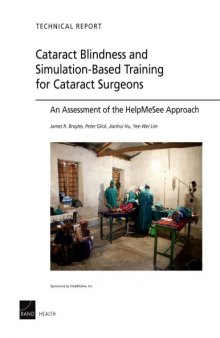 جزییات کتاب
جزییات کتاب
Cataracts account for about half of all cases of blindness worldwide, with the vast majority in developing countries, where blindness and visual impairment can reduce life expectancy and economic productivity. Most of these cases can be cured by quick, inexpensive surgical procedures, but a shortage of trained surgeons makes it unlikely that the need for such surgeries — estimated to reach 32 million cases globally by 2020 — can be met under current practices. HelpMeSee Inc. (HMS) is developing an approach to surgery training and delivery that includes use of high-fidelity simulator technology and associated curricula for high-volume training, development of a system of independent private practitioners, and training where necessary of individuals without medical degrees. RAND researchers determined that the program has the potential to scale up surgical capacity rapidly and that under optimistic assumptions, the HMS program could largely close the backlog of surgical cases in the four major regions studied, resulting in 21 million cases of cataract-caused visual impairment in 2030, compared with 134 million cases under the status quo. The program also promises to have large impacts on health and productivity, and the estimated costs per year of disability averted suggest that the intervention would be highly cost-effective in each of the regions researched. However, a number of significant challenges need to be met, particularly in the areas of outreach, remote monitoring of independent practitioners (especially non-doctors), and public and legal acceptance of non-doctors as surgeons. It is important to carefully pilot and monitor the approach before fully scaling up.



 دانلود کتاب
دانلود کتاب

 جزییات کتاب
جزییات کتاب





 این کتاب رو مطالعه کردید؟ نظر شما چیست؟
این کتاب رو مطالعه کردید؟ نظر شما چیست؟
